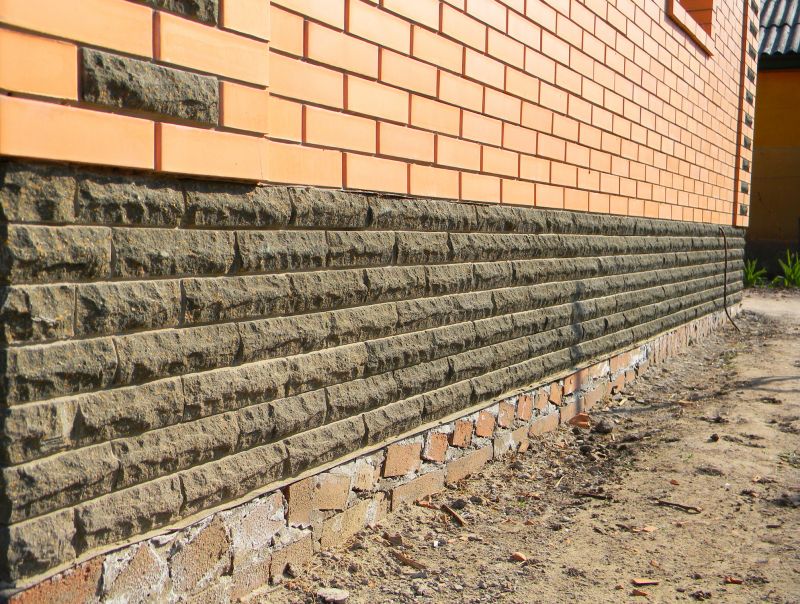Top-Rated Foundation Repair Products For Long-Lasting Home Support
Select from proven products designed to reinforce and restore your foundation for peace of mind and durability.
 Foundation repairs are a critical aspect of maintaining the structural integrity of a building, especially in regions like Muscatine, IA, where soil conditions and weather patterns can influence foundation stability. A variety of products are available to address different types of foundation issues, from minor settlement to significant shifting. Understanding the range of options can help homeowners and contractors select the most appropriate solutions for their specific needs. These products are designed to stabilize, lift, or reinforce foundations, ensuring safety and longevity for the structure.
Foundation repairs are a critical aspect of maintaining the structural integrity of a building, especially in regions like Muscatine, IA, where soil conditions and weather patterns can influence foundation stability. A variety of products are available to address different types of foundation issues, from minor settlement to significant shifting. Understanding the range of options can help homeowners and contractors select the most appropriate solutions for their specific needs. These products are designed to stabilize, lift, or reinforce foundations, ensuring safety and longevity for the structure.
Top Overall Option
Foundation Stabilization System
A versatile foundation stabilization system combines multiple components such as piers, anchors, and reinforcement plates to address a range of foundation issues. Designed for adaptability, it can be used in various soil conditions and foundation types, providing reliable support and lifting capabilities. Its modular design allows for customization based on specific project requirements, making it a comprehensive solution for many foundation repair scenarios.
Types of Products For Foundation Repairs
Epoxy Injection Kits
Used to fill cracks and bond fractured concrete, providing structural reinforcement and preventing water intrusion.
Underpinning Piers
Supports and lifts sinking foundations by transferring load to deeper, more stable soil layers.
Helical Piers
Rotatable steel piers installed into the ground to stabilize and lift foundations with minimal disturbance.
Push Piers
Steel piers driven into the soil to stabilize and lift foundations affected by settlement or shifting.
Slab Jacking/Polyurethane Foam
A method to lift and level concrete slabs using foam injections that fill voids beneath slabs.
Soil Stabilization Products
Chemical solutions that improve soil strength and reduce shifting or settling issues.
Carbon Fiber Reinforcement
Fiber strips applied to concrete cracks to reinforce and prevent further cracking.
Grouting Materials
Injectable materials used to fill voids and stabilize soil or cracks in concrete.
Anchors and Braces
Support systems that reinforce walls and prevent movement or collapse.
Drainage and Waterproofing Products
Solutions designed to manage water flow and prevent moisture-related foundation problems.
Vibration and Soil Compaction Equipment
Tools used to improve soil density around foundations, reducing settlement risks.
Concrete Repair Mortars
Specialized mortars for patching and restoring damaged concrete surfaces.
Popular Choices
Widely used for sealing cracks and restoring concrete integrity in foundations.
Commonly chosen for their strength and ease of installation in foundation stabilization.
Popular for quick and minimally invasive lifting of sunken slabs and concrete surfaces.
Favored for their adaptability and ability to support various foundation types.
Trending for their effectiveness in improving ground support and reducing future settlement.
Popular for reinforcing cracked concrete walls and preventing further damage.
Frequently used to protect foundations from moisture infiltration and water damage.
Commonly installed to stabilize basement walls and prevent bowing or collapse.
Often employed to improve soil density around foundations to reduce settling.
Used to repair surface damage and restore the integrity of concrete slabs.
Commonly used foundation repair products include epoxy injections for cracks, underpinning systems for lifting and stabilization, and soil stabilization solutions that improve ground support. Each product type serves a particular purpose and is selected based on the severity and nature of the foundation problem. Proper assessment by a qualified professional is recommended before choosing a product, as the right solution depends on soil conditions, the extent of damage, and the type of foundation involved.
In addition to structural reinforcement, some products aim to prevent future issues by improving soil conditions or providing ongoing support. These include helical piers, push piers, and slab jacking compounds, which can be installed with minimal disruption and help extend the lifespan of the foundation. When considering foundation repair products, it is essential to evaluate their compatibility with existing structures, ease of installation, and long-term performance. Consulting with experienced specialists in Muscatine can lead to more informed decisions and successful repairs.
Overall, selecting the appropriate foundation repair products involves balancing effectiveness, cost, and compatibility with your specific situation. Whether dealing with minor cracks or significant shifting, there are solutions tailored to different needs and budgets. Properly implemented, these products can contribute to the stability and safety of your home or building, offering peace of mind for years to come.
Key Buying Considerations
- Assess the severity and type of foundation issue before selecting products.
- Consult with a foundation specialist to determine the most suitable solutions.
- Verify the compatibility of repair products with your existing foundation materials.
- Consider the soil conditions and how they may influence product performance.
- Evaluate the ease of installation and whether professional help is required.
- Review the long-term durability and maintenance requirements of the products.
- Determine the potential impact on the building's structure during installation.
- Look for products that are designed for your specific foundation type, such as slab or basement.
- Check for manufacturer warranties or guarantees for added peace of mind.
- Compare costs relative to the scope of repair needed and available budget.
- Ensure that products meet local building codes and regulations.
- Consider the environmental conditions, such as moisture levels, that may affect repair longevity.
- Review customer feedback and professional recommendations for insights into product performance.
- Plan for minimal disruption to daily activities during installation if possible.
- Prioritize solutions that offer flexibility for future repairs or adjustments.
